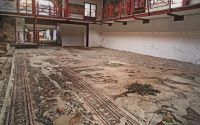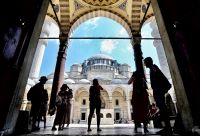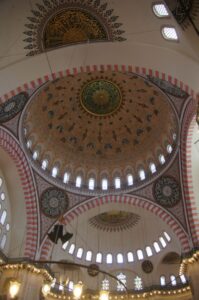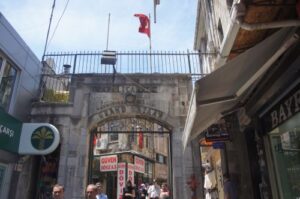I left the students at the Spice Market as they got ready to return home, and started to look for some sites that were not on my after-trip itinerary.
The first was the Archeology Museum of Turkey, but it was closed, so I wandered toward the Great Palace mosaic museum. One of the problems Turkey finds with any building in the historic district is that the builders  invariably find something they need to excavate before they build. That was the case when they discovered the floor of the great palace which had housed the Byzantine rulers. The mosaic covers about 200 feet, and is one of the largest in the world, as befits one of the largest empires in the world.
invariably find something they need to excavate before they build. That was the case when they discovered the floor of the great palace which had housed the Byzantine rulers. The mosaic covers about 200 feet, and is one of the largest in the world, as befits one of the largest empires in the world.
From there, I wandered the streets of Istanbul, going in the direction of a mosque I really wanted to see for two reasons: it contained the grave of  Suleyman the Magnificent, the Sultan who brought Islam into central Europe, being turned back (by rain and snow, said our guide) only at the gates of Vienna, by a combined European force (that was a good application of the European Union!) when the Polish army under Jon III Sobieski turned up in the nick of
Suleyman the Magnificent, the Sultan who brought Islam into central Europe, being turned back (by rain and snow, said our guide) only at the gates of Vienna, by a combined European force (that was a good application of the European Union!) when the Polish army under Jon III Sobieski turned up in the nick of time. Plus, the architect of the mosque was the famous Sinan, and I wanted to be sure to see one of his monumental buildings.
time. Plus, the architect of the mosque was the famous Sinan, and I wanted to be sure to see one of his monumental buildings.
Both expectations were rewarded, and more. To get there I had to pass one of the institutions that brings many people to Istanbul, and many Istanbul people into the streets—the Grand Bazaar, another post conquest institution, a covered market of 4,000 shops that would do China proud—everything from copperware to clothes, utensils to jewelry—low to high prices. The streets were pretty crowded with shoppers and tourists (sometimes one and the same), but every so often would be a gem—the
conquest institution, a covered market of 4,000 shops that would do China proud—everything from copperware to clothes, utensils to jewelry—low to high prices. The streets were pretty crowded with shoppers and tourists (sometimes one and the same), but every so often would be a gem—the  column Constantine brought to Constantinople that once stood in front of the Temple of Apollo at Delphi; Istanbul university, with its combination of classical/Islamic/modern buildings; and tombs of the former Sultans, including Bayazit, the second emperor, who sent his fleet to Barcelona in 1492 to bring Jewish refugees from the expulsion in Spain to the Ottoman Empire, and the late 19th century sultan who courted (and was courted by) Kaiser Wilhelm, whose gift of a fountain is still on the tour routes—especially for German visitors. But not this year. The fountain was being renovated.
column Constantine brought to Constantinople that once stood in front of the Temple of Apollo at Delphi; Istanbul university, with its combination of classical/Islamic/modern buildings; and tombs of the former Sultans, including Bayazit, the second emperor, who sent his fleet to Barcelona in 1492 to bring Jewish refugees from the expulsion in Spain to the Ottoman Empire, and the late 19th century sultan who courted (and was courted by) Kaiser Wilhelm, whose gift of a fountain is still on the tour routes—especially for German visitors. But not this year. The fountain was being renovated.